Physicist: Firstly: no. But, if you’re really set on it: maybe. The essential problems are that moving faster than light (FTL) requires impossible acceleration (not difficult but impossible in a “doesn’t make sense to talk about” kind of way), and FTL violates causality in some weird ways (for example, it allows travel backward in time).
This needs a little background, so pack a lunch.
Differently moving observers see events happen in different places. For example, if you’re in a car, everything you do seems to be happening in more or less the same place, while for someone on the side of the road all the things that you do are strung out along the car’s route.
Perspectives that are moving with respect to each other are said to be in different “frames”. So everyone in the car are in one frame, everyone waiting at a bus stop are in another frame, and everyone in an airplane overhead are in yet another frame. There’s nothing more to frames than that. So, something like “move to a different frame” just means “change speed”.
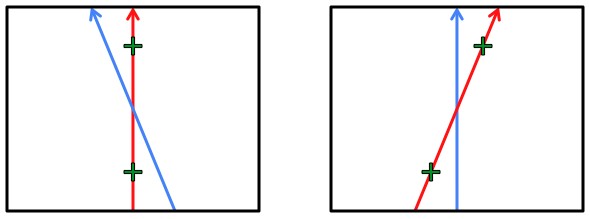
Alice (red) and Bob (blue) are moving with respect to each other. For no particularly good reason Alice sets off two firecrackers (green crosses). In Alice's frame (left) the explosions happen in the same place, one after the other. In Bob's frame (right) the explosions happen in different places. In all of the diagrams in this post, time is up and space is right/left.
Galileo (the famous one) recognized that in different frames the same events happen in different places (picture above). More than that, he realized that all of the physics that he knew of worked the same regardless of the frame (moving / not moving), and with remarkable humility he named that realization “Galilean Equivalence”.
In 1905 the ‘Stein introduced a theory about relative movement that took Galilean Equivalence (physical laws are the same in all frames) and added invariance of light speed in all frames. This is the corner-stone of relativity, and it’s called the “Einstein Equivalence Principle”. The first big result of the EEP, is that not only do different frames disagree on where events happen, but also when. It’s a bit much to go into, so if you’re interested in why, there’s an “explanation” in this post.
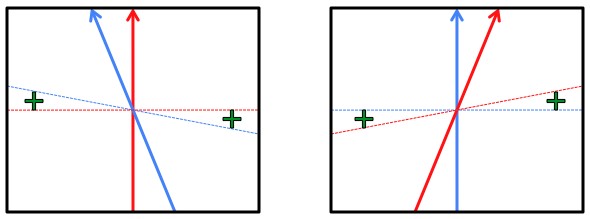
Different frames (red and blue) disagree on, among other things, what "now" is. The time that an event occurs, and even the order of events, can be changed by moving from one frame to another. The dashed lines are a single moment in time, (which are different) from each frame's perspective.
In the world according to Galileo (pre-relativity) any event could be moved relative to any other just by moving very fast. For example if two events happen in the same place, but one hour apart according to Alice, then Bob can make the second event happen 60 miles away from the first by moving at 60 miles per hour relative to Alice. Sadly, questions about “who’s right?” aren’t valid. The universe has no “preferred frame”.
In Galileo’s old-timey world view there are some restrictions to how events can be rearranged from one frame to another. Namely, the time when an event occurs never changes, and the future is always the future, and the past is always the past.
With the advent of relativity that was no longer the case, however, new restrictions popped up. A pair of events can be separated in three ways: timelike, lightlike, and spacelike.
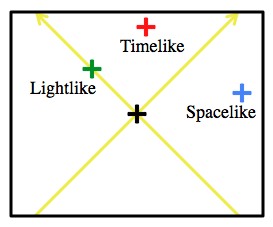
For a given event (center, black) all other events fall into one of three categories: timelike, lightlike, or spacelike separated. The yellow lines represent the path that light takes through the given event. The spacelike event can move around in its area on the right (even allowing it to occur before or after the center event), and the timelike event can move around in its area on the top.
Timelike separation means that there’s some frame in which the two events happen in the same place. That is, if you move fast enough (slower than light) you can be present at both. Timelike separated events always happen in an order: no matter what frame you’re in, everyone will agree which event happened first and which happened second. Every event you’ve ever personally experienced has been “timelike separated” from every other.
Lightlike separation means that to be present at both events you’d have to be traveling at light speed.
Spacelike separated means that there’s no way to be present at both events, even travelling at the speed of light. Things that are happening in Alpha Centauri “right now” are spacelike separated from us (right now). There is always some frame in which spacelike separated events happen at the same time, but never in the same place. Even weirder, spacelike separated events don’t have an order. Different frames will disagree on which happens first.
So, finally: here’s the issue. If you accelerate like crazy, get a huge rocket or whatever, the highest speed you can get up to is almost the speed of light. The “start” and “stop” events of your journey will always be timelike separated, regardless of how high your acceleration, or how long you accelerate for. Traveling faster than light means that your start and stop events are spacelike separated, and there is no physically real acceleration that can get you to move like that. Most people are willing to forgive that, and say: “Dude, wormholes and warp drives! S’cool!”. But those brave souls still need to contend with the second issue: causality.
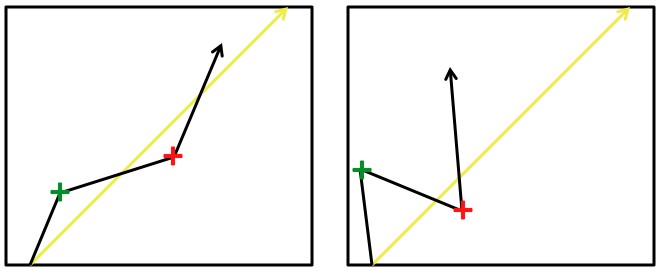
A ship with some kind of FTL drive races a beam of light. Left: The ship engages the drive (green cross), simply moves faster than light for a while, then disengages the drive (red cross). Right: The exact same situation as viewed from a different frame.
Say you’ve got the Enterprise (NCC-1701) and it works just like you’d expect: it cruises around at sub-light speeds until it engages its warp drive, which allows it to move at FTL speeds. It moves from one star system to another, then eventually disengages the drive and “drops out of warp”, no harm no foul. However! When viewed from a different frame, the same situation can be very strange.
The engage and disengage events are spacelike separated, so they don’t actually have an order. From (any one of) the proper frames, the disengage event can happen first (right half of the image above). When that’s the case you find that:
-First there’s one ship, traveling slower than light.
-Then suddenly, and without cause of any kind, two new copies of the ship appear at a place some distance away. One is traveling faster than light, and the other is traveling slower. This event corresponds with the drive being shut down.
-The FTL version travels backward until it contacts the original ship, at which point they both disappear at the moment that the original engages its drive.
Now, sure, ships coming into existence and popping out again may seem bad enough, but the big problem is that FTL travel opens the door to backward time travel (forward is fine: you’re doing it now).
By taking a couple spacelike paths that end earlier than they started you can zig-zag back in time and find yourself in the same place you started, but earlier than the time when you originally left (in the example on the right side of the picture above the route gets you back to before you left, but in a different location).

Time traveling zig-zag: If you can get into the past somewhere else once, then why not do it twice and get into your own past?
There are a lot of problems with time travel (see: “Time Cop” and “Back to the Future”). But, paradoxes and amazing one-liners aside, it seems to be very impossible. There is no indication, direct or indirect, that the future can affect the past at all (except for psychics, obviously), let alone that anything can physically move from the future to the past. So; case closed. As long as the future follows the past, nothing can travel faster than light.
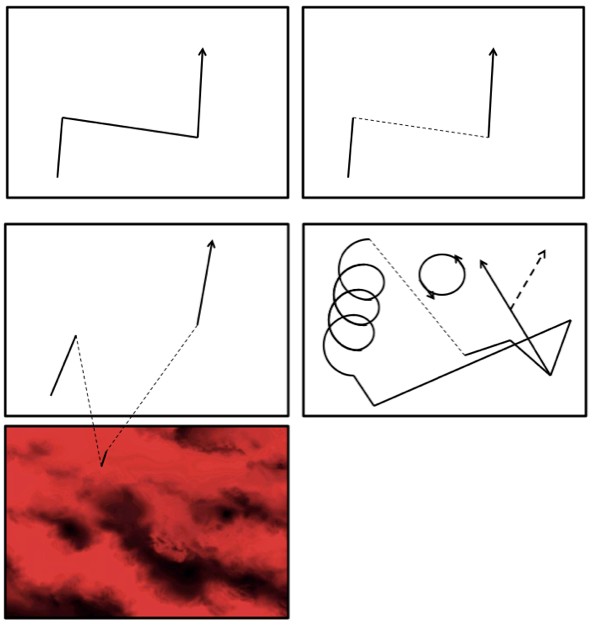
Spacetime diagrams for some sci-fi ideas about FTL (from left to right, then top to bottom): Star Trek or Star Wars, Battlestar Galactica, Babylon 5, and Dr. Who. Dashed lines are connections, not traversed distance. Click to enlarge.
But wait! Despite their romantic prospects, physicists are consummate, rarely-say-die, optimists. In that vein they’ve come up with several scenarios that (if real) would allow for FTL travel, but circumvent the whole time-travel thing.
The quickest way is to alter one of the basic assumptions of relativity; namely that all frames are equivalent. Just declare that FTL travel is possible, but only in one direction. That prevents things from zig-zagging into the past, but it also makes space travel kinda boring. Sure you can explore stuff, but you can never get home.
Alternatively, you can declare that there exists one unique frame such that no paths into the past are possible. Although other frames still get weird effects (disappearing ships, and causeless events, and whatnot), nothing can to loop back into its own past. I think this is the idea that most sci-fi shows and books are working with, but that’s meeting them more than half way.







Relating to the “fictional universe” thing, can you elaborate on the last paragraph a little? If I understand right, basically what you’re saying is if you had a universe that did possess a preferred frame of reference, then this aspect of FTL wouldn’t exist?
You wouldn’t have to worry in general about things going into their own past (which is what causes problems and paradoxes).
In a nutshell, the last paragraph is about establishing an absolute ordering of the events that any object can experience. That is, if you see an “effect” at some point, there’s no way that you can travel such that later (for you) you’ll see the “cause”.
I’m not sure that be-clears or be-murkys.
I remember reading in some book that logically considered the physics in Star Trek and explained the impossibilities and circumventions, and there was something that I *probably* didn’t understand properly, but seems relevant here.
The author did a bit of work describing that, while it would need an astronomical amount of energy, it’s still physically possible to travel distances faster than light would, by shrinking the space between you and the destination. Your ship never moves faster than light, and you still arrive a thousand years faster than you normally would.
Thoughts?
I was worrying about that. That’s why I was careful to talk about “starting” and “ending” events while ignoring everything in between.
The exact method used to get from one place to another isn’t terribly important. In Star Trek the warp drive makes the acceleration “real”, but the “causality problems” remain.
So, while locally, the ship never moves faster than light it does still move faster than light globally, and that’s what causes problems.
Confused readers should read about the “Alcubierre Drive” which is (frankly) the result of a physicist watching too much Star Trek.
Have you seen the experiment on light that moves faster than light by moving backwards? http://rochester.edu/news/show.php?id=2544
It’s not as exciting as it sounds (unfortunately). They’re basically doing this again.
Pingback: New habitable planet only 20 lightyears away - US Message Board - Political Discussion Forum
Pingback: Entanglement omnibus! | Ask a Mathematician / Ask a Physicist
Are there really causality problems with FTL?? My understanding of the equations for time v. speed is that time isn’t negative with FTL, but complex. I tend to think that is fundamentally different.
Mass is the same way. Sure, C is impossible for anything with mass, but close to it on either side isn’t. Given the interesting reports on neutrinos lately (still unconfirmed) I wasn’t all that shocked! In fact, I had generally wondered why anything with mass would consistently travel near the speed of light for any reasonable length of time. However, if they are traveling faster than light, it makes perfect sense! They can never slow down to the speed of light because of the infinite mass problem.
Fair enough!
That’s why I was careful not to talk too much about how the FTL object experiences time, and just tried to stick to where/when it ends up from the perspective of other reference frames, which is where the real problems crop up.
By complex, I meant that it was in the form of a mathematically complex number, that is a+bi and not a straight forward negative number.
Also, another error that I think many people make is to think that if it were actually a straight forward negative number, that would mean that they would travel backwards in the time of a stationary observer. In reality, It would mean they age in a negative direction to include the causality issue of arriving at there destination at the age of 20years old prior to deciding to leave for it at the age of 40.
If it can be shown that neutrinos, or anything for that matter, do travel FTL(I’m not saying that they do. I’m going to wait for the experimental data to come in..), we are definitely going to have to wrap our minds around what a+bi actually implies in terms of relativity.
Doesn’t hurt to get a head start…alas though, it makes my brain hurt. uhg! lol I hate complex numbers!
Complex; I dig. , which is equal to the amount of time (times c) experienced by an object traveling along a given path. But the important thing about
, which is equal to the amount of time (times c) experienced by an object traveling along a given path. But the important thing about  is that it’s consistent in all frames. The sign of L, or even whether L is real or complex, is pretty unimportant.
is that it’s consistent in all frames. The sign of L, or even whether L is real or complex, is pretty unimportant. is defined with the opposite sign! That said, our description of relativity is defined and described entirely from “this side” of the speed of light. FTL travel seems like it should make sense, intuitively (I mean, it’s just faster, right?), but the math stops making sense. We can’t say too many conclusive things about what an FTL object would experience.
is defined with the opposite sign! That said, our description of relativity is defined and described entirely from “this side” of the speed of light. FTL travel seems like it should make sense, intuitively (I mean, it’s just faster, right?), but the math stops making sense. We can’t say too many conclusive things about what an FTL object would experience.
It sounds like you’re talking about the spacetime interval, L, which for other people reading this, is defined as
In fact, as often as not,
Probably not “backwards aging”. Time (in every example) will always “feel” like it’s moving forward from anything’s point of view.
Pingback: Q: Is the Alcubierre warp drive really possible? How close are we to actually building one and going faster than light? | Ask a Mathematician / Ask a Physicist
Traveling faster than light means that your start and stop events are space-like separated? I thought you said traveling at light-speed means that the start and stop events are light-like separated. Could you mean that light like separation is infinite (since one’s mass would become infinite at light-speed), faster than light would be the causality problem due to individuals in different frames (people on a starship in normal space would be perceiving a space-like separation start-stop event occurring in random locations, while the people on board the trans-light vessel would be perceiving it as if it were them going to their destination? I’m trying to wrap my head around this but say an anti-gravity flux between star cores aided in the directional accuracy at which a starship “jumped” along a theoretical jump “line” of anti-gravitational flux? Thus it could use the stars as way-points, and the jump-points at these anti-gravity wells in various locations within star systems (getting into fiction a bit I know, but I’m trying to come up with a legitimate explanation for rapid interstellar travel involving other dimensions coiled up and the effects of anti-gravity and anti-matter have on these dimensions. :P)
FTL with equations:
http://www.shankaranarayanan.com/special-general-space-spatial-hyperspatial-time-relativity-hyperspace-hyper-hyperspatial-theory-faster-than-light-travel-to-stars/
Pingback: Warp Capable Ship Concept - Page 2
Well, entropic arrow of time aside, it seems to me that there’s nothing that privileges the past over the future in terms of information flow–past events cause future events, to be sure, but future events can also be extrapolated into past events, so causality can be said to be subjective. Hence, going back in time can be possible as long as causality doesn’t mind pairs of objects appearing out of nowhere. However, we know that causality does, in fact, allow pairs of objects to appear out of nowhere–this is the basis of Hawking radiation, after all. Also, it turns out that antimatter is exactly equivalent to matter with its reactions reversed in time (and also space–specifically, chirality/spin–I think), meaning that the best interpretation of Hawking radiation is particles which escape a black hole by spontaneously exceeding the speed of light–that is, going back in time. Extrapolating from there, a FTL/retrotemporal ship would be observed as a mirror-image ship traveling in reverse with negative mass that was spontaneously generated along with a ship at its destination, and eventually annhilated a younger version of the same ship. Of course, this is probably not practical on a large scale. In any case, quantum effects also smooth over paradoxical situations–for example, the grandfather paradox is resolved as being, and having always been, a superposition of one universe where a guy decides to go back in time and kill his grandfather, and another universe where a time-traveler appears and shoots a man before he can become a grandfather. (I heard that some computer simulation discovered that, given a ball fired into a wormhole that opens in the past in such a way that it will knock its past self away from said wormhole, there is always a solution for which the ball emerges from a wormhole at an angle and alters its trajectory so that it enters the wormhole at the same angle. Finding such solutions is likely much easier if superpositions are allowed.)
Considering you’re technically a scientist it’s stunning that you pose the question: “Hyperspace, warp drives, and faster than light travel: why not?” then proceed to answer as if they’re all the same thing. They are absolutely – no ambiguity – not.
It’s mind boggling that articles like this and on other science related sites need to educate themselves on what FTL is and isn’t. Having a spaceship that can travel interstellar distances in a short amount of time does not mean its travelling faster than light. Frankly it’s embarrassing that this has to be said.
FTL violates the laws of physics, period – travelling using warp or some other variation of wormhole does not.
As of right now we know – and feel free to ask the next physicist you meet that’s not you – that creating a wormhole or a warp bubble or enclosure or whatever you want to call it – does NOT violate the laws of physics. Two years ago Alcubierre published his work and while it has been modified and been written about extensively it has not been shown to violate physics as we know them.
Yes, there are problems such as exotic material which may or may not be possible to create and when the theory was first published it required fuel quantities about the size of a large gas giant but in less than a year another physicist made a modification to the equations that reduced that to the size of a minivan.
You simply cannot say that in fifty or a hundred or five hundred years we will not be able to solve these obstacles. That would be incredibly arrogant and history is littered with the forgotten names of those that said “can’t” in the world of science.
Again, FTL is impossible without rewriting the laws of physics – yeah, we get that. Other ways around interstellar distances such as warp, wormholes or variants of such are not impossible and do not violate the laws of physics. That can can be said empirically.
@Paul Davis – while it’s true that Alcubierre’s concept by itself doesn’t permit backward-in-time travel, and thereby causality paradoxes…apparently there are ways to exploit a pair of warp drives to create a true causality paradox. Allen Everett published a paper about it in 1995, which can be found here:
http://exvacuo.free.fr/div/Sciences/Dossiers/Time/A%20E%20Everett%20-%20Warp%20drive%20and%20causality%20-%20prd950914.pdf
Honestly it’s such an incredibly tedious read that I gave up on it (a few diagrams would’ve been nice, Dr. Everett). But I plan on getting back to it sometime. Because most of the writing I’ve seen on this subject strikes me as rather unconvincing, and it’s crucial to know for certain if warp field propulsion necessarily yields real, rather than apparent, causality violations.
For example, one “proof” of a warp field causality violation that I read recently described a canine traveler moving at 4C wrt an observer on the Earth, flying past the Earth and grabbing a water balloon, then striking a cat at some distance from the Earth. The cat is struck by the water balloon before it sees the canine acquire the balloon at the Earth. But this is merely an apparent causality violation from the cat’s POR. The wet cat could then watch a time-reversed image of its assailant moving backward toward the Earth, where the water balloon was acquired, and realize that the tool of its misery had been acquired in the past in a region formerly outside of its perception. No real causality violation has occurred, because if the doused cat had killed the passing canine, it wouldn’t prevent the rascally dog’s prank from transpiring. In fact I’ve yet to see a rigorous and compelling proof that superluminal travel yields actual paradoxes rather than illusory ones – perhaps Everett’s paper will convince me.
Because I can hold out hope that a deeper understanding of dark energy, or a sensible model of the cosmic inflation mechanism, may one day allow us to circumnavigate the warp field requirement for (imaginary) negative mass. But a genuine causality violation seems like a deal breaker, unless there’s another dimension of time (per Dr. Itzah Bars’ work on 2T physics).
It’s interesting that Einstein concluded that FTL causality paradoxes offer no logical objections, but he felt that their absence from our observations of the world sufficed to prove them untenable. Because absence of evidence is not evidence for absence – if superluminal travel requires conditions that can only be produced artificially, like we see in today’s metamaterials for example, then we should expect to observe new phenomena as our technological capabilities expand in the centuries and millennia ahead.
My thanks to The Physicist for providing a fun article on this subject. I just don’t find the argument convincing because I don’t see an explicit treatment here describing how FTL travel can return a voyager to the same space at an earlier time. Alcubierre’s metric maintains synchronized proper time and coordinate time, so simple warp field FTL travel forbids backwards travel through time, contrary to the “Time-traveling zig-zag” diagram above.
To avoid apparent time travel at FTL speeds would require:
1. A technologically feasible means of said speed.
2. A new relativity to describe the properties of the reconfigured spacetime that allows FTL speed.
What is nice about the new relativity theory is that it wouldn’t have to supercede the current theory. Instead, you would simply have two versions, call them subluminal and superluminal.
In the case of wormholes, you wouldn’t even need a new relativity.
Pingback: Q: With entangled particles, can you tell when/how the other particle is measured? | Ask a Mathematician / Ask a Physicist